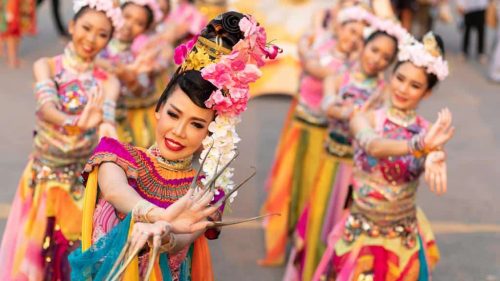Learning Thai
Learning Thai with Jen – Thai Tenses and Conjunctions

Future Tense
ja – this is how to specify something is a future tense. It can be translated as ‘will’. You place it before the verb:
pom ja bpai poo-get – I will go to Phuket.
Past Tense
lae-oh – this is how to specify something is past tense. It can be translated as ‘already’. It is placed at the end of the sentence:
pom bpai poo-get lae-oh – I have already been to Phuket.
Present Continuous
gumlung – this is how to specify something is continuing to happen. This is the English equivalent to putting ‘ing’ on the end of the verb. It is placed before the verb:
pom gumIung bpai poo-get – I am going to Phuket.
You may also hear ‘yoo’ added to the end of this format.
pom gumlung bpai poo-get yoo – I am going to Phuket.
This has the same meaning but is adding emphasis to the fact the action is continuing to happen.
Conjunctions
Conjunctions are words that connect elements of sentences. The three most common are ‘and’, ‘or’ and ‘but’. There are many other words in the English language that can be used as conjunctions. We will only describe the two other most common ones; ‘because’ and ‘therefore’.
and la
or reu
but dtair
because pror wah
therefore pror cha-nun
These conjunction words translate quite neatly between English and Thai. The Thai language uses them in very much the same way they are used in English.
and / la
The pronounciation of ‘la’ should be short as in “Last”. The vowel is shortened from the longer vowel sound in ‘lair’.
pom ja bpai poo-get la seu korng – I will go to Phuket and go shopping.
Already / La-ow
koon steve la koon john bpai la-ow – Steve and John have gone already.
or / reu
We have already seen this one in the Thai question form ‘reu bplao’ – or not. The Thai word ‘reu’ is used almost identically to the way or is used in English.
rao mee yai reu lek – We have big or small.
but / dtair
The Thai word ‘dtair’ is used almost identically to the way but is used in English.
pom yahk ja bpai dtair mai mee dtung – I would like to go but I don’t have any money.
Notes: Male speakers use Phom (“I”), and female speakers use “chun” or more formally “deechun”. Male speakers use “khrup” at the end of a sentence, and female speakers use “ka”
–

All of Jen’s students say she is the best Thai teacher they have had because she is patient with them and teaches at their pace with no pressure to learn quickly.
Jen teaches at her home in Chiang Rai
She can be reached on 0814 726 644
Learning Thai
Learning Thai: Everything You Need To Know To Master The Language

(CTN News) – Are you planning a trip to Thailand? Or maybe you want to immerse yourself in the culture and learn Thai for personal or professional reasons.
Whatever your motivation may be, learning Thai can be a challenging but rewarding experience.
In this comprehensive guide, we will cover everything you need to know to master the language, from the basics to advanced vocabulary and grammar.
Introduction
Thai is a tonal language spoken by over 60 million people worldwide, primarily in Thailand. The language has five tones, making it one of the most challenging languages for English speakers to learn.
However, with the right resources and dedication, anyone can learn Thai. Here are some tips to get you started:
- Start with the basics: Thai is a complex language, so it’s important to start with the basics. Focus on learning the Thai alphabet, basic grammar, and common phrases.
- Practice, practice, practice: The key to mastering any language is practice. Make sure to practice speaking, listening, reading, and writing in Thai as much as possible.
- Immerse yourself in the culture: Learning Thai is not just about the language; it’s also about the culture. Immerse yourself in Thai culture by watching Thai movies, listening to Thai music, and trying Thai food.
Learning Thai

Learning Thai can be a challenging but rewarding experience. Here are some essential steps to follow:
Step 1: Learn the Thai Alphabet
The first step in learning Thai is to master the Thai alphabet. The Thai alphabet consists of 44 consonants, 15 vowel symbols, and four tone marks. Here are some tips to get you started:
- Focus on learning the consonants first: The Thai alphabet is based on consonants, so it’s essential to start with them.
- Practice writing the alphabet: Writing the Thai alphabet is an essential part of learning it. Practice writing each letter until you have memorized them.
- Learn the vowel symbols and tone marks: Once you have mastered the consonants, move on to the vowel symbols and tone marks.
Step 2: Learn Basic Grammar
Once you have mastered the Thai alphabet, the next step is to learn basic grammar. Here are some essential grammar rules to get you started:
- Word order: Thai follows a subject-verb-object (SVO) word order, unlike English, which follows a subject-object-verb (SOV) word order.
- Tenses: Thai doesn’t have tenses like English. Instead, it uses time expressions to indicate the time of an action.
- Pronouns: Thai has many pronouns, each with its own level of formality. Make sure to learn the appropriate pronouns to use in different situations.
Step 3: Learn Common Phrases
Learning common phrases is an essential part of learning any language. Here are some common Thai phrases to get you started:
- Sawadee kha/khap (hello): This is a standard greeting in Thai. “Kha” is used by women, while “khap” is used by men.
- Kob khun kha/khap (thank you): This is a common expression of gratitude in Thai.
- Yin dee dtôn ráp (nice to meet you): Use this phrase when meeting someone for the first time.
Step 4: Practice Speaking and Listening
The key to mastering any language is practice. Here are some tips to help you practice speaking and listening in Thai:
- Find a language partner: Finding a native Thai speaker to practice with is an excellent way to improve your speaking and listening skills.
- Watch Thai movies and TV shows: Watching Thai movies and TV shows is an excellent way to immerse yourself in the language and culture.
Step 5: Expand Your Vocabulary
Once you have a solid foundation in Thai, it’s time to expand your vocabulary. Here are some tips to help you build your vocabulary:
- Read Thai books and newspapers: Reading Thai books and newspapers can help you learn new words and improve your reading skills.
- Use flashcards: Flashcards are a great way to learn new vocabulary. Make your own flashcards or use pre-made ones.
- Learn words in context: Learning words in context is more effective than learning them in isolation. Use new words in sentences to help you remember them.
Step 6: Study Advanced Grammar
Once you have a strong foundation in Thai, you can start studying advanced grammar. Here are some advanced grammar concepts to consider:
- Passive voice: Thai has a passive voice, which is used to emphasize the action rather than the doer.
- Conditional sentences: Thai has different conditional sentence structures than English. Make sure to study them thoroughly.
- Relative clauses: Thai uses relative clauses to describe nouns. Make sure to learn how to use them correctly.
Conclusion
Learning Thai can be a challenging but rewarding experience. By following these steps and tips, you can master the language and immerse yourself in Thai culture.
Remember to practice as much as possible, immerse yourself in the language and culture, and have fun with the learning process!
Learning Thai
What Makes Thailand Famous – 10 Things You Should Know About Thailand

(CTN News) – More than 35 million tourists travel through Thailand each year, making it one of the world’s top holiday destinations.
As a fascinating and unique country, Thailand is known for various things. There is simply too much to see and do in this tropical paradise, from stunning hotels to white-sand beaches and historic temples.
The following are ten reasons why Thailand is such a popular tourist destination.
1. Cheap Travel Costs

Thailand is an affordable place to live and travel. Thailand offers a wide variety of items at extremely low prices.
At certain wayside restaurants, you can get dinner for one dollar, a cheap stay at a guesthouse for ten dollars, and a domestic flight for twenty dollars…
It still represents a great deal compared to Western nations, despite the higher prices for higher quality.
2. Friendly Locals Why

Thai wai (hands together mini bow) is undoubtedly familiar to anyone who has heard of Thailand.
Their culture values this greatly. Thais are often among the most polite and well-mannered individuals you will ever encounter, which is why many people love visiting Thailand.
Westerners are envious of the Thai people’s easygoing attitude, which they call Mai pen rai.
Thais deal with stress and emotions lightly, unlike Westerners, who tend to worry and lead stressful lives.
People in Thailand rarely lose their cool during sporting events; instead, they simply grin and bear it.
Ask for help when you’re travelling in Thailand. Many nice Thai people are happy to recommend restaurants or give directions.
Must Read: Bangkok Is Named The World’s Best City For A Luxury Budget Vacation
3. Stunning Beaches and Famous Diving Spots

Thailand’s islands and beaches are spectacular.
With more than 2,400 km (1,500 miles) of coastline and about 1,000 islands, you can find an island or beach you love.
Both Thailand’s west and east coasts have tons of islands.
Both Koh Lipe and Koh Lanta have gorgeous coral reefs to snorkel over,
On Thailand’s west coast, Phuket, Krabi, and Koh Phi Phi are well known for their well-developed facilities.
Thailand’s east coast has breathtakingly secluded beaches like Ko Samui, Ko Pha-Ngan, and Ko Tao.
4. Thai Cuisine and Street Food

There’s a lot of love for Thai food around the world.
Thai food is loved worldwide because of its flavours, temperatures, textures, and cooking methods.
Among other specialties, you must try tom yum goong, pad Thai, and som tam.
Thai street food is also great. You can buy prepared foods like meals, snacks, fruits, and beverages at many inexpensive kiosks around Bangkok.
5. Ladyboys

“Ladyboy” and “kathoey” are surprisingly common Thai terms. Thailand is a free nation where ladyboys live among Thais. They work as hairdressers, filmmakers, sex workers, waitresses, models, and other jobs that women.
Bangkok, Pattaya, Phuket, and Chiang Mai are some of Thailand’s most popular tourist destinations where you can see ladyboy cabarets.
6. Parties and Nightlife

Thailand’s most popular party spot in Southeast Asia. Nightlife in Thailand is diverse, with hip beach bars, boutique breweries, and upscale rooftop bars.
Koh Phangan’s Full Moon Party, Bangkok’s Khao Sarn Road, and Pattaya’s clubs are some of the top party spots.
7. Muay Thai (Thai boxing)

Muay Thai, or Thai boxing, is Thailand’s national sport and one of the most well-known fighting sports in the world.
Thai boxing gyms and arenas abound in Thailand. People come from all over to learn this martial art.
Thailand has a lot of renowned arenas and performances, like Bangkok’s Muay Thai Live, Pattaya’s Max Muay Thai, and Phuket’s Patong Boxing Stadium.
8. Crazy Traffic

Thailand has the worst traffic in the world. Especially in Bangkok, you’ll notice how awful the traffic is when you arrive.
Tuk Tuks and motorbikes often squeeze through narrow spaces when a road is supposed to have two lanes. There’s a lot of traffic in the city at rush hour.
9. Thai Massage

The greatest massages in the world are in Thailand! It stretches your muscles deep.
Several Thai massage styles include yoga, oil, foot, and pinda (herbal, relaxing movement).
You can get them for a reasonable price.
Thai massages cost 200 THB (about 6 USD).
Thailand vacations aren’t complete without this pleasure.
10. The Rich History and Culture

There’s a lot of history in Thailand. The oldest Thai artifacts dated back to the Paleolithic era 20,000 years ago.
Many of its oldest temples have Khmer architecture, influenced by Laos, Vietnam, and Cambodia.
Several old ruins can be found in Bangkok, Sukhothai, and Chiang Mai.
Thailand’s many cultural forms, like Thai puppet shows and traditional dances, also incorporate it.
Related CTN News:
Bangkok Ranked 2nd On The List Of Best Cities For Digital Nomads
Learning Thai
Do You Need A TEFL Certificate To Teach English In Thailand?
Do You Need A TEFL Certificate To Teach English In Thailand? For many people, Thailand is a dream travel destination.
Filled with beautiful beaches in the South, mountains in the north, and one of the most exciting cities, Bangkok, located right in the center, what’s not to love.
Foreigners from all around the world are looking for a means to live and work in Thailand and one of the best ways to do that is by working as an English teacher.
The TEFL industry in Thailand is huge and schools are always on the lookout for new, energetic teachers.
Thailand’s economy is growing and people are learning English to compete for jobs at bigger companies.
Because of this English isn’t just taught at schools, but also at language centers where additional classes are offered.
So in Thailand, you can find teaching jobs at public schools, private schools, universities, and language centers.
Some of you might be finishing up school or university, or have even worked at a company as an accountant, lawyer, or engineer, and are looking for a new experience.
Teaching in Thailand gives you a chance to experience a new place and culture, as well as to enrich the lives of kids.
This provides people with a sense of fulfillment that a monotonous office job just doesn’t.
But because some of you have never worked as a teacher before or even worked in another country, you might not know what the requirements are to actually land a job as an English teacher.
From a quick online search, you would probably see some basic requirements such as having a degree as well as a TEFL certificate.
Now a degree is a legal requirement to teach English in Thailand. Without one, you won’t be able to get a work permit.
Being a native English speaker is preferred by schools but it’s not at all a requirement.
A TEFL certificate is actually also not a requirement and not important at all. Most articles you read online about TEFL certificates are written by TEFL course providers trying to promote their courses.
But just because you don’t need it, doesn’t mean that it won’t be helpful. It’s just that you should decide for yourself if you are confident enough to teach without any training or not.
If you have never taught in any way before then taking a course could be extremely helpful.
It’s also worth noting that some schools do use a TEFL certificate to filter candidates if they receive a lot of applicants.
These schools also do give preference to in-person TEFL courses over online ones.
There are definitely some good online TEFL schools, but there are also many low-quality ones out there.
A TEFL course is a short program that teaches you how to teach English as a foreign language.
The focus is on younger kids, but the skills can be applied to students of any age.
As a TEFL teacher, you will most likely be teaching primary students, but some teachers do teach high school English in Thailand.
TEFL courses in Thailand are located in the most popular cities including Bangkok, Chiang Mai, and Phuket, but you can also take one online or in your home country.
But if you plan to teach in Thailand, taking a TEFL course over there will be much more beneficial as you will about how to teach in Thailand instead of a generalized education.
You will learn about Thai culture and how to handle specific situations in Thai schools.
You will learn how to build a strong work relationship with your Thai coworkers and how to respectfully treat your students and their parents.
You will also get a chance to meet many teachers doing the same thing as you. Having a strong community is important, especially when moving to a new country.
But not all TEFL courses are good. It’s important to look out for some specific things to make sure that a course is actually going to be helpful.
A good course isn’t just going to teach you grammar skills. It’s going to teach you how to stand up in front of a class filled with kids who have short attention spans and keep them interested in what you have to say.
It’s going to teach you valuable skills in classroom management and common games and teaching techniques to use in your classes.
If you look at some of the best-reviewed TEFL course providers in Thailand such as TravelBud and Ninja Teacher, you will see that they offer so much more than just teacher training.
They offer all the assistance you need when it comes to moving to Thailand as well as post-course support, by helping you to find a job.
A Good TEFL program focuses on practical training instead of just theory.
Before you join a course make sure that they have practical training else you would be wasting your time.
Related CTN News:
Thailand Schedules General Election For May 7, 2023
Thailand’s government lifts the ban on foreigners with Covid visiting the country
More Than 5 Million Foreign Tourists Arrived in Thailand in 9 Months
-

 News3 years ago
News3 years agoLet’s Know About Ultra High Net Worth Individual
-
Entertainment1 year ago
Mabelle Prior: The Voice of Hope, Resilience, and Diversity Inspiring Generations
-

 Health3 years ago
Health3 years agoHow Much Ivermectin Should You Take?
-

 Tech2 years ago
Tech2 years agoTop Forex Brokers of 2023: Reviews and Analysis for Successful Trading
-

 Lifestyles2 years ago
Lifestyles2 years agoAries Soulmate Signs
-

 Health2 years ago
Health2 years agoCan I Buy Ivermectin Without A Prescription in the USA?
-

 Movies2 years ago
Movies2 years agoWhat Should I Do If Disney Plus Keeps Logging Me Out of TV?
-

 Learning2 years ago
Learning2 years agoVirtual Numbers: What Are They For?
